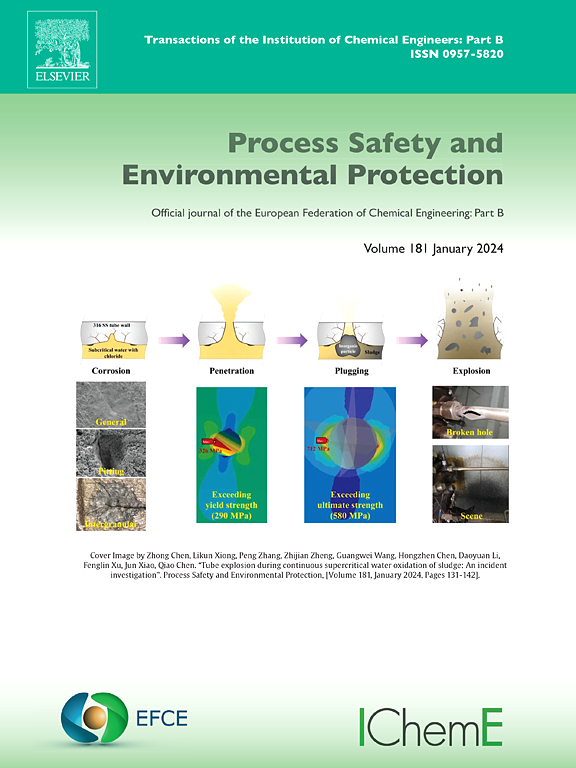A multilayer analytical model for reactive contaminant transport through cutoff wall-aquifer systems: Addressing pre-installation contamination and source removal scenarios
IF 7.8
2区 环境科学与生态学
Q1 ENGINEERING, CHEMICAL
引用次数: 0
Abstract
Cutoff walls are a type of engineered barrier widely used to control contaminant transport in the subsurface environment, particularly at legacy contaminated sites. However, most existing models assume initially uncontaminated strata and a persistent source of release, which limits their applicability under realistic site conditions. This study aims to develop a multilayer analytical model that incorporates spatially variable initial contaminant concentrations and accommodates both source-release and source-removal scenarios. The model explicitly couples contaminant advection, dispersion, adsorption, and degradation across a three-domain system (inside aquifer-cutoff wall-outside aquifer), allowing for more accurate performance prediction of vertical barriers. A series of scenario comparisons were conducted using the proposed model, examining the effects of initial pollution status, source dynamics, hydraulic gradients, and barrier permeability. Results show that ignoring pre-existing contamination may lead to an overestimation of breakthrough time by more than 200 %, while source removal can reduce outlet concentrations by up to 50 % depending on wall placement. Sensitivity analysis indicates that reducing barrier permeability (from 10⁻⁸ to 10⁻⁹ m/s) or reversing hydraulic gradients can delay contaminant breakthrough time by an order of magnitude. Practical design curves are introduced to optimize barrier thickness, installation timing, and position, demonstrating that early installation, expanded control zones, and high-adsorption/low-permeability backfilling significantly reduce required barrier dimensions. This work advances predictive tools for cutoff wall performance at legacy contaminated sites, providing actionable insights for engineers to balance remediation costs and environmental safety.
反应性污染物通过截流墙-含水层系统传输的多层分析模型:解决安装前污染和源去除情况
截流墙是一种工程屏障,广泛用于控制污染物在地下环境中的运移,特别是在遗留污染场地。然而,大多数现有的模型都假设最初未受污染的地层和一个持续的释放源,这限制了它们在实际现场条件下的适用性。本研究旨在建立一个多层分析模型,该模型包含空间可变的初始污染物浓度,并适应源释放和源去除两种情况。该模型明确耦合了污染物平流、分散、吸附和降解在三域系统(含水层内-含水层外)中的作用,从而可以更准确地预测垂直屏障的性能。利用提出的模型进行了一系列情景比较,考察了初始污染状态、源动态、水力梯度和屏障渗透率的影响。结果表明,忽略预先存在的污染可能会导致突破时间的高估超过200 %,而根据壁的放置,去除源可以使出口浓度降低高达50% %。敏感性分析表明,降低屏障渗透性(从10⁻⁸到10⁻⁹m/s)或逆转水力梯度可以将污染物突破时间延迟一个数量级。通过引入实际设计曲线来优化屏障厚度、安装时间和位置,表明早期安装、扩大控制区和高吸附/低渗透回填显著降低了所需的屏障尺寸。这项工作为遗留污染场地的防渗墙性能提供了预测工具,为工程师平衡修复成本和环境安全提供了可行的见解。
本文章由计算机程序翻译,如有差异,请以英文原文为准。
求助全文
约1分钟内获得全文
求助全文
来源期刊

Process Safety and Environmental Protection
环境科学-工程:化工
CiteScore
11.40
自引率
15.40%
发文量
929
审稿时长
8.0 months
期刊介绍:
The Process Safety and Environmental Protection (PSEP) journal is a leading international publication that focuses on the publication of high-quality, original research papers in the field of engineering, specifically those related to the safety of industrial processes and environmental protection. The journal encourages submissions that present new developments in safety and environmental aspects, particularly those that show how research findings can be applied in process engineering design and practice.
PSEP is particularly interested in research that brings fresh perspectives to established engineering principles, identifies unsolved problems, or suggests directions for future research. The journal also values contributions that push the boundaries of traditional engineering and welcomes multidisciplinary papers.
PSEP's articles are abstracted and indexed by a range of databases and services, which helps to ensure that the journal's research is accessible and recognized in the academic and professional communities. These databases include ANTE, Chemical Abstracts, Chemical Hazards in Industry, Current Contents, Elsevier Engineering Information database, Pascal Francis, Web of Science, Scopus, Engineering Information Database EnCompass LIT (Elsevier), and INSPEC. This wide coverage facilitates the dissemination of the journal's content to a global audience interested in process safety and environmental engineering.
 求助内容:
求助内容: 应助结果提醒方式:
应助结果提醒方式:


